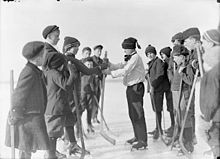
Hockey is a term used to denote a family of various types of both summer and winter team sports which originated on either an outdoor field, sheet of ice, or dry floor such as in a gymnasium. While these sports vary in specific rules, numbers of players, apparel, and playing surface, they share broad characteristics of two opposing teams using a stick to propel a ball or disk into a goal.

Ice hockey is a team sport played on ice skates, usually on an ice skating rink with lines and markings specific to the sport. It belongs to a family of sports called hockey. In ice hockey, two opposing teams use ice hockey sticks to control, advance, and shoot a closed, vulcanized, rubber disc called a "puck" into the other team's goal. Each goal is worth one point. The team which scores the most goals is declared the winner. In a formal game, each team has six skaters on the ice at a time, barring any penalties, one of whom is the goaltender. Ice hockey is a full contact sport, and is considered to be one of the more physically demanding team sports. It is distinct from field hockey, in which players move a ball around a non-frozen pitch using field hockey sticks.
Roller hockey is a form of hockey played on a dry surface using wheeled skates. It can be played with traditional roller skates or with inline skates and use either a ball or puck. Combined, roller hockey is played in nearly 60 countries worldwide.
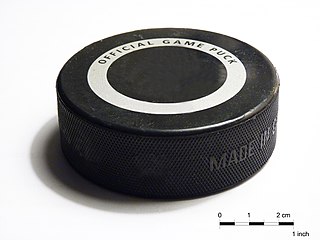
A hockey puck is either an open or closed disk used in a variety of sports and games. There are designs made for use on an ice surface, such as in ice hockey, and others for the different variants of floor hockey which includes the wheeled skate variant of inline hockey. They are all designed to serve the same function a ball does in ball games.

In many team sports that involve scoring goals, the goalkeeper is a designated player charged with directly preventing the opposing team from scoring by blocking or intercepting opposing shots on goal. Such positions exist in bandy, rink bandy, camogie, association football, Gaelic football, international rules football, floorball, handball, hurling, field hockey, ice hockey, roller hockey, lacrosse, ringette, rinkball, water polo, and shinty, as well as in other sports.

A face-off is the method used to begin and restart play after goals in some sports using sticks, primarily ice hockey, bandy, floorball, broomball, rinkball, and lacrosse.
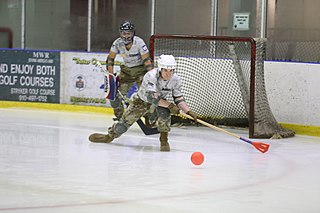
Broomball is a both a recreational and organized competitive winter team sport played on ice or snow and is played either indoors or outdoors, depending on climate and location. It is a ball sport and is most popularly played in Canada and the United States.
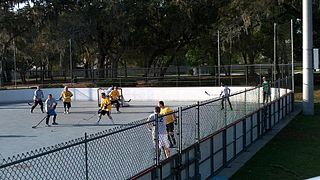
Street hockey is a collection of team sport variants played outdoors either on foot or with wheeled skates, using either a ball or puck designed for play on flat, dry surfaces. The object of every game is to score more goals than the opposing team by shooting the ball or puck into the opposing team's net. All games are derivatives of either the sport of ice hockey, floor hockey, bandy, and/or field hockey.

Floor hockey is a broad term for several indoor floor game codes which involve two teams using a stick and type of ball or disk. Disks are either open or closed but both designs are usually referred to as "pucks". These games are played either on foot or with wheeled skates. Variants typically reflect the style of ice hockey, field hockey, bandy or some other combination of sport. Games are commonly known by various names including cosom hockey, ball hockey, floorball, or simply floor hockey.

Roller in-line hockey, American roller hockey or inline hockey, is a variant of hockey played on a hard, smooth surface, with players using inline skates to move and ice hockey sticks to shoot a hard, plastic puck into their opponent's goal to score points. The sport is a very fast-paced and free-flowing game and is considered a contact sport, but body checking is prohibited. There are five players including the goalkeeper from each team on the rink at a time, while teams normally consist of 16 players. There are professional leagues, one of which is the National Roller Hockey League (NRHL). While it is not a contact sport, there are exceptions, i.e. the NRHL involves fighting.
This is a list of common terms used in the sport of ice hockey along with the definitions of these terms.
Foot hockey is a sport related to hockey in which the only equipment is a ball, most commonly a tennis ball, that is kicked about the playing surface by the players in an attempt to score a goal on the opposing goaltender. It has been described as a "combination of hockey, soccer and handball" and "a form of soccer with a tennis ball". Foot hockey is played indoors or outdoors; footwear is optional indoors, but must be worn by either all or none of the players. It may be unisex or coed. Participation in foot hockey produced fewer catastrophic injuries than other winter sports in studies from 1986 to 1995.

The Victoria Skating Rink was an indoor ice skating rink located in Montreal, Quebec, Canada. Opened in 1862, it was described at the start of the twentieth century to be "one of the finest covered rinks in the world". The building was used during winter seasons for pleasure skating, ice hockey and skating sports on a natural ice rink. In summer months, the building was used for various events, including musical performances and horticultural shows. It was the first building in Canada to be electrified.
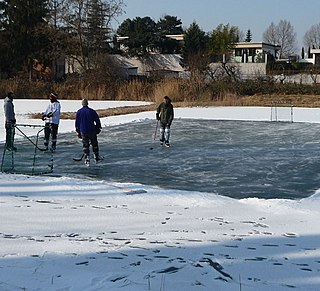
Pond hockey is a form of ice hockey similar in its object and appearance to traditional ice hockey, but simplified and designed to be played on part of a natural frozen body of water. The rink is 50 to 80 percent the size of a standard NHL-specification rink, and has no boards or glass surrounding it; usually only a barrier of snow keeps the puck in play. In addition, because there are no protective barriers behind the goal to contain high errant shots, the top of the goal is lower, in fact only slightly taller than the width of a puck, and the game does not have a formal goalie. Because of these differences, pond hockey places more emphasis on skating and puckhandling ability and less on shooting and checking. Non-competitive pond hockey is played with improvised goals, rinks of a variety of sizes, and no boards or snow barriers. There can only be 4 players playing per team at a time but have many subs to sub in.
Ice hockey is believed to have evolved from simple stick and ball games played in the 18th and 19th centuries in Britain, Ireland, and elsewhere, primarily bandy, hurling, and shinty. The North American sport of lacrosse was also influential. These games were brought to North America and several similar winter games using informal rules developed, such as shinny and ice polo, but were later absorbed into a new organized game with codified rules which today is ice hockey.
The origin of ice hockey was bandy, a game that has its roots in the Middle Ages. Just as for practically all other sports, the game of bandy achieved its modern form during the 19th century in England, more exactly in the Fen district on the East coast. From the Fen district the game was spread to London and from London to the Continent during the second half of the 19th century. British soldiers stationed in eastern Canada brought the game to the North American continent in the 1850s and '60s. You could find similar games there, played by immigrants and by Indians. Thus there were a number of different games played on skates with a stick and ball and with varying rules in America before ice hockey was invented.
Underwater ice hockey is a minor extreme sport that is a variant of ice hockey. It is played upside-down underneath frozen pools or ponds. Participants wear diving masks, fins, and wetsuits and use the underside of the frozen surface as the playing area or rink for a floating puck. Competitors do not use any breathing apparatus but instead surface for air every 30 seconds or so.
The National Hockey League All-Star Skills Competition, officially the NHL All-Star Game SuperSkills Competition during certain past years, is an event on the night preceding the National Hockey League All-Star Game. Started at the 41st National Hockey League All-Star Game in Pittsburgh in 1990, the NHL uses the event to showcase the talents of its all-star participants. The All-Star teams select representatives for each event, with points awarded to the winning team.
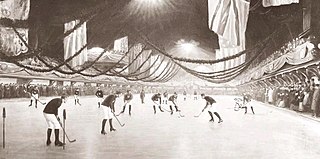
On March 3, 1875, the first recorded indoor ice hockey game took place at the Victoria Skating Rink in Montreal, Quebec. Organized by James Creighton, who captained one of the teams, the game was between two nine-member teams, using a rubber "puck". Members used skates and sticks used for outdoor hockey and shinny games in Nova Scotia, where Creighton was born and raised. It is recognized as the first organized ice hockey game.

Ice hockey is the most popular indoor sport in Scotland, with a fairly established presence in each of the population centres and a spectator attendance lower only than football and rugby union. The term "hockey" is usually reserved for field hockey in Scotland, and "ice hockey" is normally referred to by its full form.
Shinny is an informal type of ice hockey.
